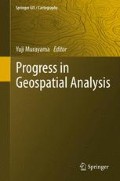Abstract
Geographic information systems (GIS) provide both theory and methods that have the potential to facilitate the development of spatial analytical functions and various GIS data models. There are several network models in GIS, such as river networks, utility networks and transportation or road networks. Among these, GIS road network data models are important for solving problems in urban areas such as transportation planning, retail market analysis, accessibility measurements, service allocation and more. Understanding the road network patterns in urban areas is important for human mobility studies, because people are living and moving along the road networks. A network data model allows us to solve daily problems such as finding the shortest path between two locations, looking for the closest facilities within a specific distance or estimating drive times. Although many network models are conceptually simple they are mathematically complex and require computational resources to model the problem.
Access this chapter
Tax calculation will be finalised at checkout
Purchases are for personal use only
References
Bell M, Iida Y (1997) Transportation network analysis. Wiley, Chichester
Bhat C, Handy S, Kockelman K, Mahmassani H, Gopal A, Srour I, Weston L (2002) Development of an urban accessibility index: formulations, aggregation, and application. Center for Transportation Research, The University of Texas at Austin. Report no. FHWA/TX-02-4938-4
Dijkstra EW (1959) A note on two problems in connexion with graphs. Numerische Mathematik 1:269–271
Dill J, Portland OR (2003) Measuring network connectivity for bicycling and walking. In: Joint congress of ACSP-AESOP, Leuven
Fischer M (2004) GIS and network analysis. In: Hensher D, Button K, Haynes K, Stopher P (eds) Handbook of transportation geography and spatial systems. Elsevier, Amsterdam, pp 391–408
Frank LD, Engelke P (2005) Multiple impacts of the built environment on public health: walkable places and the exposure to air pollution. Int Reg Sci Rev 28:193–216
Frank LD, Stone B Jr, Bachman W (2000) Linking land use with household vehicle emissions in the central Puget Sound: methodological framework and findings. Transp Res Part D 5:173–196
Handy S, Niermeier DA (1997) Measuring accessibility: an exploration of issues and alternatives. Environ Plann A 29:1175–1194
Hansen WG (1959) How accessibility shapes land use. J Am Plann Inst 25:73–76
Hess PM, Moudon AV, Snyder MC, Stanilov K (1999) Site design and pedestrian travel. Transp Res Rec 1674:9–19
Hillier B (1996) Space is the machine: a configurational theory of architecture. Cambridge University Press, Cambridge
Hillier B, Hanson J (1984) The social logic of space. Cambridge University Press, Cambridge
Jiang B (1999) SimPed: simulating pedestrian crowds in a virtual environment. J Geogr Inf Decis Anal 3:21–30
Lee J (2005) 3D GIS in support of disaster management in urban areas. Retrieved from http://www.directionsmag.com/article.php?article_id=2049
Leslie E, Coffee N, Frank L, Owen N, Bauman A, Hugo G (2007) Walkability of local communities: using geographic information systems to objectively assess relevant environmental attributes. Health Place 13:111–22
Levinson DM, Krizek KJ (2005) Access to destinations. Elsevier, Kidlington
Lwin KK, Murayama Y (2009) Interactive online micro-spatial population analysis based on GIS estimated building population. In: URISA’s 2009 annual conference & exposition, Anaheim (student paper award)
Lwin KK, Murayama Y (2011) Modelling of urban green space walkability: eco-friendly walk score calculator. Comput Environ Urban Syst 35:408–420
Moudon AV, Lee C, Cheadle AD, Garvin C, Johnson DB, Schmid TL, Weathers RD (2007) Attributes of environments supporting walking. Am J Health Promot 21:448–459
O’Sullivan D, Morrison A, Shearer J (2000) Using desktop GIS for the investigation of accessibility by public transport: an isochrone approach. Int J Geogr Inf Sci 14:85–104
Peponis J, Zimring C, Choi YK (1990) Finding the building in wayfinding. Environ Behav 22:555–590
Pirie GH (1979) Measuring accessibility: a review and proposal. Environ Plann A 11:299–312
Reilly MK (2002) The influence of urban form and land use on mode choice: evidence from the 1996 bay area travel survey. Presented at the annual meeting of the Transportation Research Board, Washington
Rodrigue J-P, Comtois C, Slack B (2009) The geography of transport systems, 2nd edn. Routledge, New York
Sherman L, Barbara B, Kondo W (1974) Method for evaluating metropolitan accessibility. Transp Res Rec 499:70–82
Taaffe EJ, Gautheir H Jr (1973) Geography of transportation. Prentice-Hall, Englewood Cliffs
Wachs M, Kumagi TG (1973) Physical accessibility as a social indicator. Socio Econ Plann Sci 7:437–456
Zhan FB, Noon CE (1998) Shortest path algorithms: an evaluation using real road networks. Transp Sci 32:65–73
Zhu Q, Li Y, Tor YK (2006) 3D dynamic emergency routing. GIM-Int 20(6). http://www.gim-international.com/issues/articles/id674-D_Dynamic_Emergency_Routing.html
Author information
Authors and Affiliations
Corresponding author
Editor information
Editors and Affiliations
Rights and permissions
Copyright information
© 2012 Springer Japan
About this chapter
Cite this chapter
Lwin, K.K., Murayama, Y. (2012). GIS Network Model in Geospatial Analysis. In: Murayama, Y. (eds) Progress in Geospatial Analysis. Springer, Tokyo. https://doi.org/10.1007/978-4-431-54000-7_12
Download citation
DOI: https://doi.org/10.1007/978-4-431-54000-7_12
Published:
Publisher Name: Springer, Tokyo
Print ISBN: 978-4-431-53999-5
Online ISBN: 978-4-431-54000-7
eBook Packages: Earth and Environmental ScienceEarth and Environmental Science (R0)

